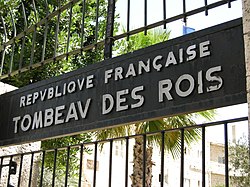| Revision as of 13:48, 16 March 2011 edit85.65.99.40 (talk) links← Previous edit | Revision as of 14:08, 16 March 2011 edit undoAnomieBOT (talk | contribs)Bots6,569,186 editsm Dating maintenance tags: {{Fact}}Next edit → | ||
| Line 24: | Line 24: | ||
| == Events == | == Events == | ||
| In 1996, the Jerusalem Festival in East Jerusalem, featuring Arab and international artists, was held at the Tomb of the Kings. {{fact}} | In 1996, the Jerusalem Festival in East Jerusalem, featuring Arab and international artists, was held at the Tomb of the Kings. {{fact|date=March 2011}} | ||
| ==See also== | ==See also== | ||
Revision as of 14:08, 16 March 2011

The Tombs of the Kings (they) (Arabic "قبور السلاطين) are a collection of monumental rock-cut tombs in East Jerusalem, 820 meters north of the Old City walls.
The grandeur of the site lead to the belief that the tombs had once been the burial place of the kings of Judah. Now it is believed that Queen Helena of Adiabene of Mesopotamia was buried there. According to this theory, Queen Helena chose the site to bury her son Isates and others of her dynasty.
Location

The site is just east of the Green Line, at the junction of Nablus Road and Saladin Street. The gate of the property is marked "Tombeau des Rois."
History
In 1847 the Ottoman governor of Jerusalem started the excavation in the site. The excavation was then followed in 1863 by French archaeologists, was acquired by Pereire brothers, famous bankers of the Second Empire, who gave to France in 1886 (controversial). The tombs are located underneath a piece of land that has a small stone house on top of it. The house was built by and inhabited by a Muslim family called Irhimeh up until mid 1990s. The tomb was described by the Greek geographer Pausanias as the second most beautiful tomb in the world (after the tomb of Mausolus, one of the seven wonders of the ancient world).
Archaeological findings
From the house there is a 9 meter wide staircase that was originally paved and leads to a forecourt. Water collected in the baths from a channel system carved in the steps. The entrance to the tombs is via a courtyard, of the same date, cut from the rock, itself entered via a rock-cut arch (facade). The 28-meter facade was crowned with three pyramids which no longer exist but are described by the Roman Jewish historian Josephus and other ancient sources. The architrave was originally supported by two pillars, fragments of which were found in the excavations.
The tombs are arranged on two levels around a central chamber, itself entered from the courtyard via an antechamber that goes down into a dimly lit maze of chambers; the access from the antechamber to the exterior courtyard could be sealed closed by rolling a round stone across it, and the stone still remains in-situ. In the first century A.D., a "secret mechanism" operated by water pressure moved the stone. Probably a small amount of water pressure activated a system of weights to open the tomb. Two of the eight burial chambers have arcosolia, resting places made of a bench with an arch over it. Some of the arcosolia have triangular niches where oil lamps were placed to give light during the burial process.
The two most common types of tombs in the first century CE are found in this tomb complex. Shaft tombs were long narrow shafts in which the deceased were placed and closed with a stone slab which probably had the name of the occupant inscribed on it. Channels in the center of the shafts were probably carved to drain the water that seeped through the rock.

The tombs are now empty, but previously housed a number of sarcophagus; they were excavated by a French archaeological mission headed by Louis Felicien de Saulcy, who took them back to France. They are exhibited at the Louvre. The French government took possession of the site after the death of a French citizen who purchased the land in 1874.
One of the sarcophagi bears an inscription in Hebrew and Syriac identifying the corpse within as that of Queen Sara (Tzara Malchata); this is thought to refer to Helena, the Queen of Adiabene, who converted to Judaism in 30 CE and changed her name to Sara. The decorative architecture of the tomb complex is Seleucid, which would fit with this identification.
Events
In 1996, the Jerusalem Festival in East Jerusalem, featuring Arab and international artists, was held at the Tomb of the Kings.
See also
References
- . "Ancient Jerusalem's Funerary Customs and Tombs: Part Three Ancient Jerusalem's Funerary Customs and Tombs: Part Three, L. Y. Rahmani, The Biblical Archaeologist, Vol. 45, No. 1 (Winter, 1982), pp. 43-53,
- Josephus, Antiquities of the Jews 20:4:3
- Eusebius of Caesarea, Ecclesiastical History 2:12
31°47′18″N 35°13′46″E / 31.788218°N 35.229466°E / 31.788218; 35.229466
Categories: